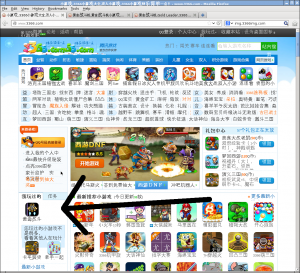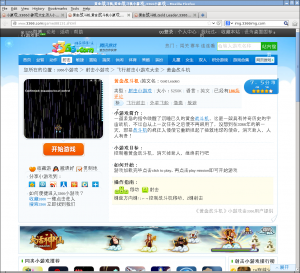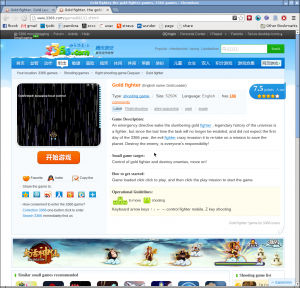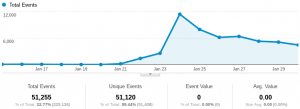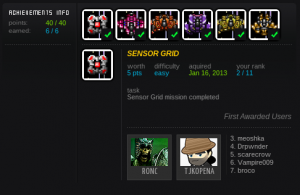![]() About four days short of a month after launch, earlier today my small Flash game Gold Leader crossed over 102,000+ visitors, some 151,000+ plays. Google Analytics believes just under 58,000 of them are actually unique and 45,000 are returning players. That’s super sweet from a “People played my game!” perspective. The breakdown on who they are is also pretty interesting. Basically, I’m big in China, except that to actually be “big” in China you would need to be tremendously huge.
About four days short of a month after launch, earlier today my small Flash game Gold Leader crossed over 102,000+ visitors, some 151,000+ plays. Google Analytics believes just under 58,000 of them are actually unique and 45,000 are returning players. That’s super sweet from a “People played my game!” perspective. The breakdown on who they are is also pretty interesting. Basically, I’m big in China, except that to actually be “big” in China you would need to be tremendously huge.
Growth
This is a plot of the game’s ‘load’ event, kicked off right after the preloader finishes and the sponsor splash screen plays:
With any minimal knowledge of the Flash game scene, you can probably basically guess at the story from just glancing at the chart. For others, it’s important to understand a key characteristic of most Flash games: There is a ridiculous number of game sites out there, and they generally all steal and share each other’s games in an attempt to capture eyeballs from other sites. Hence, the sponsor requested that Gold Leader not be locked down to their particular site. The timeline:
- The game was launched on GameShed.com on January 16th. Due to the scale of the later hits it’s not noticeable, but the game starts at about a 100 players a day and ramps up a bit.
- January 21st or so I put the GameShed branded version on Newgrounds and Kongregate. It sits in judgement for a bit over a day on each, essentially a staging area they use for adventurous users to rate new, unscreened content and determine if and how it’ll be posted to the main page.
- The game eventually makes it out, even with a reasonable rating on Newgrounds (currently about a 3.25 after 1721 views). Due to the kind of silly way judgement seems to work though, it never really hits the front page—it’s blocked by games that were posted later and are actually rated lower but got more votes more quickly so they came out of judgement faster and sorted to the top by original posting date. You have to go to the second page of new games to find Gold Leader, but it’s out there.
- Around the same time, GameShed also puts the game on FlashGameDistribution.com, a service that portals and arcades use to share Flash game files. This throws more potential hosts into the mix, with some 95 portals having looked at the game through there as of this moment.
- Within a day or so, searches like “gold leader flash game” start turning up hundreds of sites hosting the game. Almost all of this is certainly coming from hosts that pulled the game off either Newgrounds or Kongregate. I can’t really guess which, though I kind of thing the latter even though the game’s even less prominent there.
- Play explodes, at least in relative terms.
- As it drifts of the main pages of all these sites, it goes down pretty rapidly but after a couple weeks is still clocking in a steady 3800 unique visitors per day.
After a while I would have been convinced the steady hits were bots crawling sites and somehow/for some reason loading the SWF or something ridiculous like that, if not for the steady uptick in detailed play stats. At this point, 7,000 people have played all the way through the entire game, about 13 minutes of play if you can manage to do it straight through, pretty hard to do.
Demographics
Not too surprisingly given what I gathered from reading what few discussions of Flash game play numbers I’ve come across, most of the traffic is from China:
- China 88,000
- Romania 2,200
- USA 2,000
- Russia 1,200
- Italy 800
- Vietnam 750
- Unknown 700
- Slovakia 500
- Germany 400
- Ukraine 430
And on from there. The game has been played from at least 127 countries. My geography/social studies-major sister will no doubt be pleased that I had actually heard of all of them. In any event, someone from Botswana, Brunei, and a bunch of other barely-heard-of-in-the-US nations have played Gold Leader. That’s great!
The Romanian and Russian and other Eastern European hits aren’t too surprising. I don’t actually know, but believe GameShed operates out of Eastern Europe, quite possibly one of those two, so that could easily account for those numbers.
Shame on the British though for not playing more! Even the French played more!
Rocketship Games Breaches the Great Internet Wall
In any event, China. A huge portion of the hits are coming from just three Chinese sites: 3366.com, 4399.com, and 7k7k.com. Interestingly, the original entry point into China, whichever site it was, probably either lifted the game from GameShed.com or went searching for assets and found them there. GameShed created icons for their menus and achievement badges with (to me) distinctive higher-resolution purple and grey bars behind the ships, which the Chinese sites seem to be using.
Fantastically, these sites all have little translation guides telling Chinese language players what inscrutable English symbols to click on to start the game and other required tasks:
Hacked!
Less fantastically, the Chinese sites have all added their own little preloaders that essentially cut my preloader down to a click-through. It doesn’t really affect me since I’m not particularly trying to monetize the game, but this tracks with what I’ve read about Chinese game portals cutting out ads from other games. I can see why developers and sponsors would be annoyed. That’s a huge percentage of your views to have stolen away.
Way, way more awesomely though (in some sense), at least one site hacked the game. From 4399.com, I present to you: Gold Leader—Prime Fighter Invincible Version! The title pretty much says it all. Incredibly, they altered the bytecode of the game such that you can’t take damage and you can’t fail the missions. Personally I find it pretty boring to play, but it’s rated a solid half a star better than the standard version on their site…
Either way, that’s ridiculous. Everything else seems to work fine. You even get the warnings that you’re in danger of failing, it just doesn’t ever happen. That’s some scalpel-like precision, especially when you figure the game’s written in Haxe so the bytecode probably even looks and decompiles differently from a game produced in a more standard fashion using AS3 or Flash Builder.
Previously I noted how this experience has made real for me the bandwidth and other resource requirements consumed even on the very very minor end of “Internet scale.” This development has changed my thinking on cheating. Previously I’d always figured hacking and cheating couldn’t possibly be a huge concern for any but the most serious games. That’s completely wrong, you will be hacked and there will be cheaters. I’m not even rated that highly on this site but they put in what to me seems a non-trivial effort to do so.
Fortunately their players still don’t seem to be actually scoring particularly high or they’re not submitting to the Mochi leaderboard, so that’s still sane.
Games as Communication
Back on the more positive side, 3366.com actually has a steady stream of commenters. I have little idea what they’re actually saying in detail, the Google Translate version is amazing nonsense about “Wife of this game is too fun” and “Go after an airplane. Do not know the horse of God. The same point is useful only. :o” But, judging from the emoticons (and Google Translate) they seem to be pretty positive and bearing out the 7.5 rating Gold Leader‘s maintaining there:
In some ways that’s pretty crazy and almost frustrating, to have this whole non-trivial audience I can’t communicate with—I want to tell them I appreciate it! I had already started thinking about it earlier, but have definitely now worked out some basic support structures to do localization of future games, swapping in translated game text. It just seems like all these fans should at least be rewarded by having the menus in their own language. Most of them may not even realize you can fully configure the controls, which is a bummer.
Beyond that though, it’s actually really satisfying. One of the best moments of this whole project was an early pre-review from a paid first impressions tester on FlashGameLicense, who ranted at length about its virtues and declared:
The piece reflects and projects legit understanding of what it wants to do, it is evident that it is being made by people who love and play this style themselves, and the fact that it is a rigorous and MEAN shooter, makes it an eminent declaration already.
That pretty much made the whole effort worthwhile right there, much more so than the sponsorship. Gold Leader is not the greatest thing in game history. But an awful lot of love and attention was put into making it run great, play well, and be a deserving homage to all the shooters I played endlessly as a kid. From the minimal aesthetic to the conscious decision to ratchet up the difficulty at the risk of turning away more casual gamers, there was real design intent toward that end. It was deeply rewarding then to have someone get exactly what the project was all about, be on exactly the same frequency, and really appreciate it.
With these comments and hits though, it turns out there’s a lot of people on that wavelength. Literally directly opposite from me across the globe, with a completely incompatible language, over what I would otherwise have assumed to be wholly unrelatable backgrounds, we’ve got this in common: We all recognize and love a good old school shoot ’em up. That I could get this art, this love letter, across so many barriers and into the hands of all these people who would understand and appreciate it is why this, the Internet age, is the greatest of all eras.

